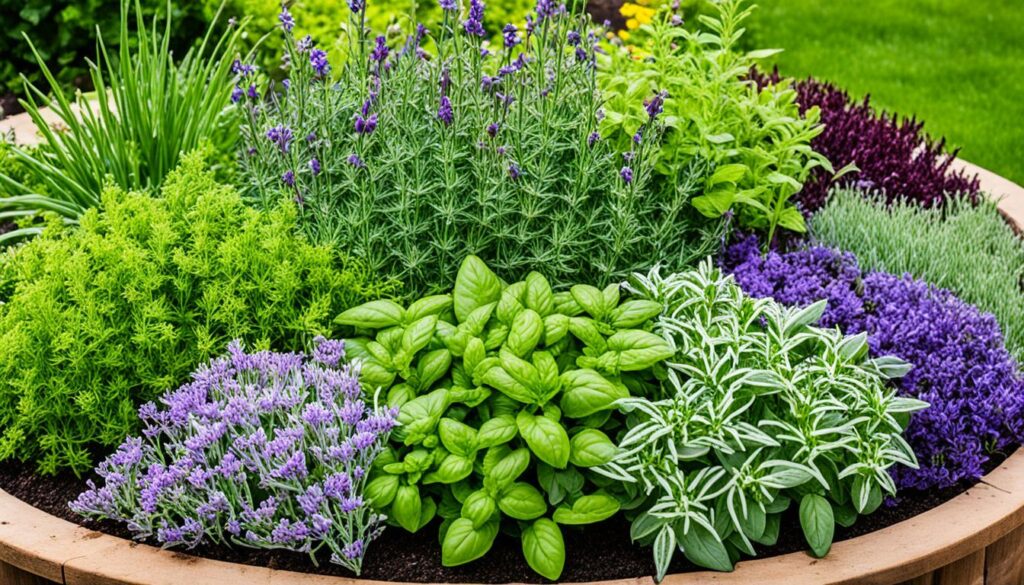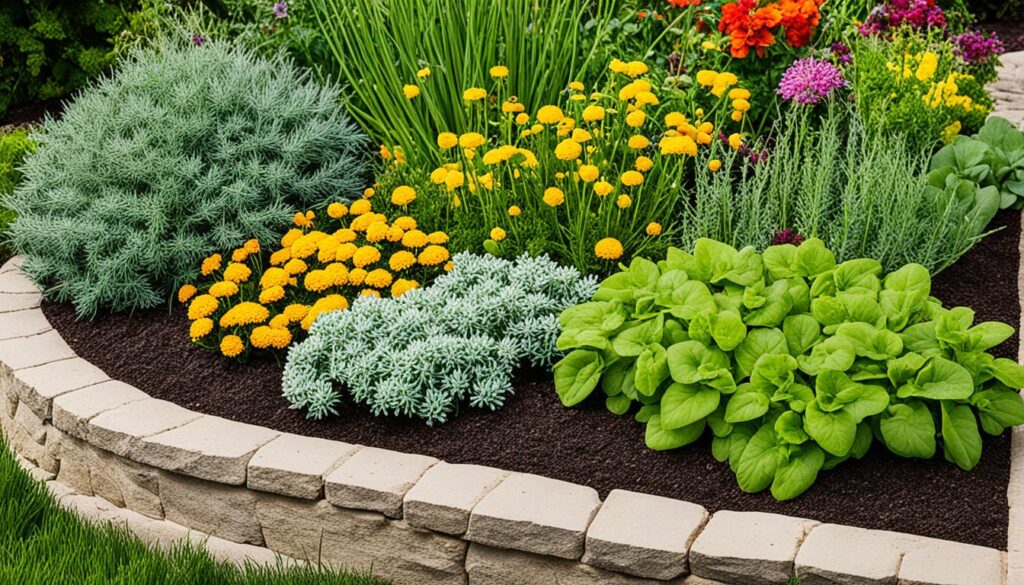Companion Planting for Natural Pest Control
Are you tired of fighting garden pests with harsh chemicals? Companion planting is an old trick that uses plants to keep pests away naturally. It’s a way to control pests without using toxic pesticides. But how does it work, and which plants work best together? Let’s explore the secrets of using plants to control pests naturally.
Key Takeaways
- Companion planting uses plants to keep pests away naturally.
- Having many plants in your garden makes it hard for pests to find what they want.
- Herbs like mint, tansy, and wormwood keep pests away.
- Flowers like nasturtiums and marigolds bring in insects that eat pests.
- Planning your garden carefully can help you control pests naturally.
Understanding the Principles of Companion Planting
Creating a pest-resistant garden begins with the core principles of companion planting. The main idea is that plant diversity helps keep pests away. By mixing different flowers, herbs, and vegetables, you make it tough for pests to find a favorite spot.
More Plant Diversity Equals Fewer Pests
Diverse plants confuse pests with their different smells and looks. This makes it hard for pests to find their usual food. Also, a garden full of different plants is a home for beneficial insects. These include ladybugs, lacewings, and parasitic wasps that eat garden pests.
Creating a Habitat for Beneficial Insects
It’s important to have a lot of beneficial insects in your garden. They help keep pests away naturally. By adding flowers, herbs, and various plants, you make a place where these helpful insects can live and work well.
| Beneficial Insect | Pest Targeted |
|---|---|
| Ladybugs | Aphids, mealybugs, scale insects |
| Lacewings | Aphids, mites, thrips, leafhoppers |
| Parasitic Wasps | Caterpillars, aphids, whiteflies |
“A diverse garden provides a habitat for beneficial insects like ladybugs, lacewings, and parasitic wasps that prey on common garden pests.”
Herbs that Deter Pests
Gardeners can use aromatic herbs for natural pest control. These herbs make your garden tastier and keep pests away from your veggies and flowers.
Mint, Tansy, Catnip, Wormwood, and More
Mint, tansy, catnip, and wormwood keep pests away. Plant them near your veggies to make a natural barrier. But, be careful with mint and tansy as they can spread a lot.
Other herbs like dill, basil, parsley, fennel, and cilantro also repel pests. Mixing these herbs creates a strong system that keeps your garden healthy.
Allowing Vegetables to Flower
Letting your veggies flower is another good idea. This attracts beneficial insects like ladybugs and lacewings, which eat garden pests.
Using herbs, veggies, and beneficial insects together makes a garden that’s beautiful and full of life without pesticides.
Flowers for Attracting Beneficial Insects
Some flowers are great at drawing in good bugs that eat garden pests. These beneficial insect-attracting flowers are key in fighting pests naturally, cutting down on harmful chemicals.
Nasturtiums and Marigolds
Nasturtiums are called the “queen” of pest-fighting flowering companion plants. They keep pests away and work as a trap crop, pulling pests away from your veggies. Marigolds bring in ladybugs and lacewings, which eat garden pests. These flowers also protect against nematodes, tiny worms that harm plant roots.
Cosmos, Alyssum, and Flowering Vegetables
Cosmos and alyssum are great for beneficial insect-attracting flowers. They draw in pollinators and bugs that eat pests, keeping your garden balanced. Letting your veggies flower also brings in these helpful bugs for natural pest control.
| Flower | Beneficial Insects Attracted | Additional Benefits |
|---|---|---|
| Nasturtiums | Predatory insects, ladybugs | Act as a trap crop, deter pests |
| Marigolds | Ladybugs, lacewings | Protect against nematodes |
| Cosmos | Pollinators, predatory insects | Visually appealing, easy to grow |
| Alyssum | Predatory insects, parasitic wasps | Compact growth, cascading flowers |
Adding these beneficial insect-attracting flowers to your garden makes a natural, sustainable ecosystem. These flowering companion plants are not just pretty. They’re key to keeping your garden healthy and balanced.
Testing Companion Planting Combinations
Many recommended companion plant combinations exist, but testing them in your garden is key. What works in one spot might not work in another. By trying out different plant pairs, you can find the best natural pest control for your garden.
Herbs to Repel Cabbage Worms and Cabbage Loopers
Studies show that thyme, nasturtium, and onion work well together. They keep cabbage worms and cabbage loopers away from your cabbage and other brassicas. These herbs form a natural barrier to protect your plants.
Herbs for Squash Bug and Tomato Hornworm
Marigold and nasturtium stop squash bugs, while basil and thyme keep tomato hornworms and armyworms away. Adding these plants to your garden helps control pests without using harsh chemicals.
Trying out different plant combinations can lead you to the best natural pest control for your garden. Watch how these plants work together in your garden and adjust as needed.
“By testing different companion planting combinations, you can discover the most effective natural pest control solutions for your garden.”
Stopping the Use of Pesticides
In organic pest control, it’s key to avoid pesticides, even the organic kind. Pesticides might seem like a fast way to get rid of garden pests. But, they can really hurt your garden’s balance.
Pesticides, natural or synthetic, can hurt good insects too, not just pests. This messes up the natural balance in your garden. Instead, work on making healthy soil and a garden full of different plants. This helps many insects and other creatures.
- Manually remove pests when possible, using techniques like hand-picking or using floating row covers to physically exclude pests.
- Encourage a diverse population of insects by providing a variety of flowering plants that attract beneficial predators and pollinators.
- Amend your soil with compost and other organic matter to promote robust plant growth and resilience against pests.
By not using pesticides, you’re helping your garden become a balanced, organic pest control system. This way, you protect your plants and the environment. Plus, you get a lasting way to deal with garden pests.
“The best defense against pests is a healthy, thriving garden ecosystem – not chemicals.”
| Benefits of Avoiding Pesticides | Drawbacks of Using Pesticides |
|---|---|
| Encourages a diverse, balanced ecosystem | Disrupts the natural predator-prey relationships |
| Promotes healthy soil and plant growth | Can harm beneficial insects and other organisms |
| Provides a sustainable, long-term solution | May lead to the development of pest resistance |
companion planting for pest control
Certain aromatic herbs can be your garden’s best friends for natural pest control. Plants like basil, mint, rosemary, lavender, oregano, and thyme can keep pests away. These herbs have the power to repel many unwanted garden pests.
Basil, Mint, and Rosemary: Versatile Pest Deterrents
Basil keeps flies, mosquitoes, carrot flies, asparagus beetles, and whiteflies away. Its strong smell is a natural way to keep pests off. Mint grows fast and keeps aphids, cabbage moths, carrot flies, spider mites, and ants away. Rosemary is great for keeping cabbage worms, the Mexican bean beetle, and carrot flies off your plants.
Lavender, Oregano, and Thyme: Aromatic Pest Deterrents
Lavender makes your garden look beautiful and keeps moths away. Oregano and thyme control pests like cabbage worms, cabbage loopers, flea beetles, and aphids. Planting these herbs can create a natural barrier against pests in your garden.
| Herb | Pests Deterred |
|---|---|
| Basil | Flies, mosquitoes, carrot flies, asparagus beetles, whiteflies |
| Mint | Aphids, cabbage moths, carrot flies, spider mites, ants |
| Rosemary | Cabbage worms, Mexican bean beetles, carrot flies |
| Lavender | Moths |
| Oregano | Cabbage worms, cabbage loopers, flea beetles, aphids |
| Thyme | Cabbage worms, cabbage loopers, flea beetles, aphids |
By adding these fragrant, pest-deterring herbs to your garden, you can make a natural and sustainable garden. This approach helps your plants thrive without using harsh chemical pesticides.

Attracting Beneficial Insects
Planting herbs and flowers can help attract beneficial insects to your garden. These insects can naturally control pests. Aromatic plants like parsley, fennel, and cilantro draw in ladybugs, lacewings, parasitic wasps, and hoverflies. These insects eat aphids, caterpillars, and other pests.
Let these plants flower to attract more beneficial insects. The flowers offer nectar and pollen, which are great food for these insects. This encourages them to live and thrive in your garden.
Parsley, Fennel, and Cilantro
Parsley, fennel, and cilantro are not just tasty herbs. They also help control pests naturally. These plants have small flowers that ladybugs, lacewings, and parasitic wasps love. These insects eat pests like aphids, caterpillars, and mites.
- Parsley attracts hoverflies, which lay eggs near aphids. Their larvae eat the aphids.
- Fennel is a favorite of lacewings. Their larvae eat aphids and mealybugs.
- Cilantro draws parasitic wasps. These wasps lay eggs inside caterpillars, controlling their numbers.
By using these beneficial insects, you can cut down on chemical pesticides. This makes your garden more sustainable and eco-friendly.
Planning Your Companion Planting Strategy
When planning your companion planting strategy, think about what each plant needs and how they work well together. Make sure they like the same amount of light, water, and soil. This way, they’ll grow well together, making your garden healthy and full of life.
Considering Plant Needs and Compatibility
Start by looking at your garden’s conditions like sunlight, moisture, and soil type. Then, find plants that like the same things. For example, put sun-loving herbs like basil, mint, and rosemary with veggies that also need lots of sun. This helps everyone grow better together.
Inspecting Plants and Removing Infested Ones
Checking your plants often is key to a pest-free garden. Look for signs of pests like leaves that are not their usual color, eaten leaves, or bugs. If you find a plant that’s really infested, take it out right away to stop the problem from getting worse. This keeps your companion planting strategy working well.
| Plant Needs | Companion Planting Compatibility |
|---|---|
| Light Requirements | Match sun-loving plants with other sun-loving varieties |
| Water Needs | Pair plants with similar watering requirements |
| Soil Type | Choose plants that thrive in the same soil conditions |

Plan your companion planting strategy well, think about how plants fit together, and watch for pests. This way, you can have a garden that’s full of life and keeps pests away naturally.
Conclusion
Using companion planting can make your garden pest-free without harmful chemicals. By mixing different herbs, flowers, and vegetables, you can keep pests away and attract helpful insects. It might take some trial and error to find the best plant combinations for your garden. But, the long-term benefits of companion planting are worth it for a sustainable, natural pest control.
As you keep improving your companion planting skills, you’ll see a balanced garden ecosystem. Pests will be kept in check, and helpful creatures will flourish. With time and attention, you can cut down on harmful pesticides. This way, you’ll enjoy a pest-free garden that’s full of life.
Now, you know the main ideas and perks of companion planting. You can turn your garden into a lively, eco-friendly haven. Let the variety of plants work together to protect your garden from pests. Enjoy the benefits of a rich, healthy harvest.
FAQ
What are the principles of companion planting for pest control?
What are some common herbs that can be used as companion plants to deter pests?
What flowers are effective at attracting beneficial insects to the garden?
How can I test different companion planting combinations in my garden?
Why is it important to avoid using pesticides when practicing companion planting?
What other herbs can be used for natural pest control in the garden?
How can I attract more beneficial insects to my garden?
What should I consider when planning my companion planting strategy?
Source Links
- 10 Must-Have Blooms for Your 2025 Garden
- The Health Advantages of Gardening You Need to Know
- How to Create a Small Vegetable Garden Layout Plan: A Beginner’s Guide
- DIY Garden Projects for Small Spaces: Upcycling Ideas to Maximize Your Garden
- Watering Techniques for Small Gardens: Ensuring Your Plants Thrive
- Small Border Plants for Landscaping: Adding Beauty and Functionality to Your Garden
- Year-Round Small Space Gardening: Seasonal Planting Tips for Maximum Harvest
- Essential Tools for Small-Space Gardening: What You Really Need
- The Ultimate Guide to Container Vegetables: What to Grow in Small Spaces
- Budget-Friendly Gardening: How to Create a Thriving Garden on a Tight Budget
- How to Optimize Sunlight in Small Gardens: Tips for Better Plant Growth
- DIY Vertical Planters: Creative Ideas for Small Space Gardening
- Companion Planting for Small Vegetable Gardens: Boost Growth and Deter Pests
- Container Gardening Essentials: Choosing the Right Pots, Soil, and Plants
- Vertical Gardening Techniques: Maximizing Your Small Space with Climbers and Vines
- How to Build a Raised Bed Garden in a Small Backyard: Step-by-Step Guide
- The Best Vegetables for Small-Space Gardens: High-Yield Varieties You Need to Grow
- Smart Vegetable Garden Layouts for Small Spaces: Maximizing Your Green Thumb in Compact Areas
- 40. Best Practices for Managing a Sustainable Garden Year-Round
- Building a Wildlife Pond for Biodiversity
- Advanced Techniques in Sustainable Gardening
- How to Create a No-Till Garden
- The Mental Health Benefits of Gardening
- Using Technology to Enhance Sustainable Gardening
- Getting Certified Organic: Steps and Benefits

Leave a Reply